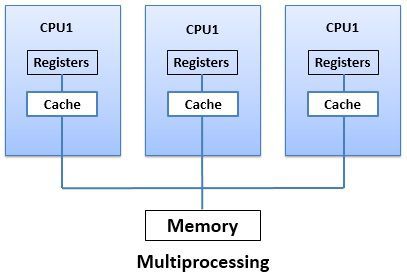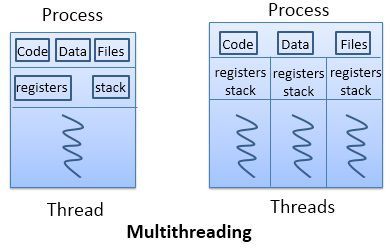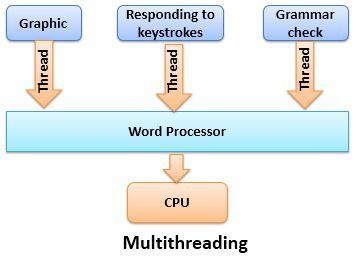 Multiprocessing and Multithreading both adds performance to the system. Multiprocessing is adding more number of or CPUs/processors to the system which increases the computing speed of the system. Multithreading is allowing a process to create more threads which increase the responsiveness of the system.
Multiprocessing and Multithreading both adds performance to the system. Multiprocessing is adding more number of or CPUs/processors to the system which increases the computing speed of the system. Multithreading is allowing a process to create more threads which increase the responsiveness of the system.
I have figured some more differences between multiprocessing and multithreading which I have discussed with the help of comparison chart shown below.
Content: Multiprocessing Vs Multithreading
Comparison Chart
| Basis for Comparison | Multiprocessing | Multithreading |
|---|---|---|
| Basic | Multiprocessing adds CPUs to increase computing power. | Multithreading creates multiple threads of a single process to increase computing power. |
| Execution | Multiple processes are executed concurrently. | Multiple threads of a single process are executed concurrently. |
| Creation | Creation of a process is time-consuming and resource intensive. | Creation of a thread is economical in both sense time and resource. |
| Classification | Multiprocessing can be symmetric or asymmetric. | Multithreading is not classified. |
Definition of Multiprocessing
A multiprocessing system is one which has more than two processors. The CPUs are added to the system to increase the computing speed of the system. Each CPU has its own set of registers and main memory. Just because CPUs are separate, it may happen that one CPU must not have anything to process and may sit idle and the other may be overloaded with the processes. In such cases, the processes and the resources are shared dynamically among the processors.
Multiprocessing can be classified as symmetric multiprocessing and asymmetric multiprocessing. In symmetric multiprocessing, all processors are free to run any process in a system. In Asymmetric multiprocessing, there is a master-slave relationship among the processors. The master processor is responsible for allotting the process to slave processors.
If the processor has integrated memory controller then adding processor would increase the amount of addressable memory in the system. Multiprocessing can change the memory access model from uniform memory access to nonuniform memory access. The uniform memory access amounts the same time for accessing any RAM from any Processor. On the other hands, non-uniform memory access amounts longer time to access some part of memory than the other parts.
Definition of Multithreading
Multithreading is the execution of multiple threads of a single process concurrently within the context of that process. Now let us first discuss what is a thread? A thread of a process means a code segment of a process, which has its own thread ID, program counter, registers and stack and can execute independently. But threads belonging to the same process has to share the belongings of that process like code, data, and system resources.
Creating separate processes for each service request consumes time and exhaust system resources. Instead of incurring this overhead, it is more efficient to create threads of a process.
 To understand the multithreading concept let us take an example of a word processor. A word processor, displays graphic, responds to keystrokes, and at the same time, it continues spelling and grammar checking. You do not have to open different word processors to do this concurrently. It does get happen in a single word processor with the help of multiple threads.
To understand the multithreading concept let us take an example of a word processor. A word processor, displays graphic, responds to keystrokes, and at the same time, it continues spelling and grammar checking. You do not have to open different word processors to do this concurrently. It does get happen in a single word processor with the help of multiple threads.
 Now let us take into consideration the benefits of multithreading. Multithreading increases the responsiveness as if one thread of a process is blocked or performing the lengthy operation, the process still continues. The second benefit of multithreading is resource sharing as several threads of a process share same code and data within the same address space.
Now let us take into consideration the benefits of multithreading. Multithreading increases the responsiveness as if one thread of a process is blocked or performing the lengthy operation, the process still continues. The second benefit of multithreading is resource sharing as several threads of a process share same code and data within the same address space.
Creating a thread is economical as it shares the code and data of the process to which they belong. So the system does not have to allocate resources separately for each thread. Multithreading can be increased on multiprocessing operating system. As multithreading on multiple CPUs increases parallelism.
Key Differences Between Multiprocessing and Multithreading
- The key difference between multiprocessing and multithreading is that multiprocessing allows a system to have more than two CPUs added to the system whereas multithreading lets a process generate multiple threads to increase the computing speed of a system.
- Multiprocessing system executes multiple processes simultaneously whereas, the multithreading system let execute multiple threads of a process simultaneously.
- Creating a process can consume time and even exhaust the system resources. However creating threads is economical as threads belonging to the same process share the belongings of that process.
- Multiprocessing can be classified into symmetric multiprocessing and asymmetric multiprocessing whereas, multithreading is not classified further.
Conclusion
The benefits of multithreading can be gradually increased in multiprocessing environment as multithreading on a multiprocessing system increases parallelism.
Riya says
best answer.
Somya says
Difference between hypertext and hypermedia
Armin says
That’s what I’m looking for thank you very much.
JACK says
Ultra nice !
Sandeep p says
Thanks. It was precise!
siva nagendram yarra says
Thank u so much for this information….
Riya tyagi says
This answer is very specific and clear..!!!
cosmas says
the answer is very clear
Xuy says
Great explanation ✌✌
Apurba Raj Acharya says
Nice article..
Alex says
Finally Best Answer over multiple i have searched.
Thank you
Alex